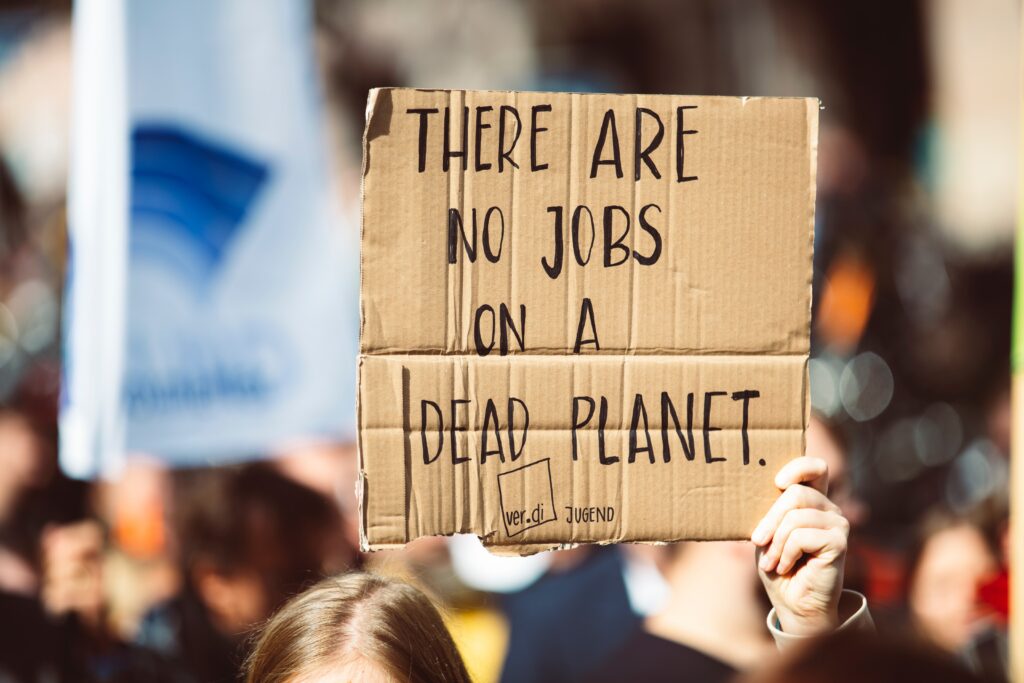This discussion is old, we have been talking about managing or stabilizing climate change for a long time. However, if we look at global emissions of CO2 and other greenhouse gases, since then, we see that these emissions into the atmosphere are greater than ever. It’s everywhere: if we need to stabilize the 1.5 °C rise, global emissions must reach zero by 2050.

We have a very gloomy scenario approaching and very little movement from society in general, despite the fact that it is imperative that we must redesign our economies. In almost every industry, there are many options that we can adjust to in order to make this low-carbon world a reality.
According to the UN, sustainable development has been defined “as development that meets the needs of the present without compromising the ability of future generations to meet their own needs”. This refers to four distinct areas: human/social, economic and environmental – known as the four pillars of sustainability:
- Economical – improving the flow of financial capital and facilitating trade, including the knowledge, skills, competencies and other attributes embodied in individuals that are relevant to economic activity.
- Environmental – recognizing the diversity and interdependence of living systems, the goods, and services produced by the world’s ecosystems, and the impacts of ecological footprints.
- Socio-political and human – interaction between institutions and people, expressive functions of human values, aspirations and well-being, and ethical and humanitarian issues. Investments in health and education systems, access to services, nutrition, knowledge, and skills.
How about business?
It’s evident that companies have an important contribution to the social and environmental problems that we have today. They increase water and soil pollution, emit greenhouse gases, and create dense urban communities around their factories and offices. If companies are part of the problem, they are also part of the solution.
In the year 2000, when the United Nations published its Global Compact, Environmental, Social, and Corporate Governance (ESG) began to be more recognized and valued among companies and the community. ESG states that corporate sustainability starts with the value system, this implies restructuring the organizational operation, in order to fulfil the fundamental responsibilities in terms of human rights, labour, environment and anti-corruption.
Sustainability is among a number of human social movements that have occurred throughout history: human rights, racial equality, gender equality, labour relations and environment conservation, for example. Thus, it is intuitive to understand how the socio-political and human spheres are often delegated to HR’s direction. But it shouldn’t just be always like this. HR should not be the owner of sustainability in organizations. It needs to fit into all business operations. HR facilitates the development of a sustainable culture, but it should be on the agenda of the entire leadership team. Due to a bad habit, many companies hand over (throw?) projects to HR roles only because they haven’t found another sector directly linked to the theme. Remember events, voluntary actions and community campaigns in general that no one knows for sure why, but it was your company’s HR who carried them out.
With all areas of the companies involved with sustainable development, they must retain talent better through the connection between corporate and individual values; improve customers’ perception of value, be less susceptible to operational errors, reduce waste of resources, improve efficiency and access credit more easily. Faced with this scenario, all leaders of a company have two options: manage change or be dragged by it.
Below, I suggest some initiatives that leaders and HR can take to boost the sustainability agenda in organizations and put it into the organization’s strategic planning:
. Identify practices and needs for this change, and develop a fact-based argument to support them.
. Engage as many leaders as possible.
. Train sustainability supporters, ambassadors, or multipliers within the teams.
. Create a sustainability committee, with the participation of all company areas.
. Involve the internal communication area.
. Propose the creation of a sustainability report, KPIs, and measures and involve several areas in the construction.
. Suggest that sustainability is a competency or skill to be included in a performance appraisal to identify the success of individuals and teams contributing to sustainable development. Be sure what this attitude means.
. Engage people in various formats: workshops, folders, discussion groups, book clubs, videos, gifts, prizes, newsletters, campaigns, etc.
. Focus on inspiring the future generation of leaders;
. Think about the most effective ways for the company to link its market performance with sustainable development goals.
Finally, remember that your organization is embedded in totalizing social systems that are powerful and difficult to change, so try to think about the work you could do to facilitate this transition. Also, think about the power of culture and the importance of managing it to make this transition successful. Consider strategic transformation and different organizational approaches to making the sustainable transition in an ambidextrous way: organizational growth combined with sustainable practices.
Sometimes we feel that we need world leaders to do more and better, and we get frustrated with the lack of progress, which can be discouraging and negatively affect our actions. However, we have the potential to make a big difference in our teams and company, creating spaces and conditions to strengthen a culture of sustainability, and involving people leading by example. Promoting impact in the world is doable. And the sustainable transition is also imperative and urgent, after all, the only possible future we have is a green one.
References:
- https://svs.gsfc.nasa.gov/4975
- https://www.un.org/es/observances/ozone-day
- https://www.un.org/es/ga/president/65/issues/sustdev.shtml
- https://www.carbonbrief.org/in-depth-qa-the-ipccs-sixth-assessment-on-how-to-tackle-climate-change/
- https://climateactiontracker.org/global/cat-thermometer/
